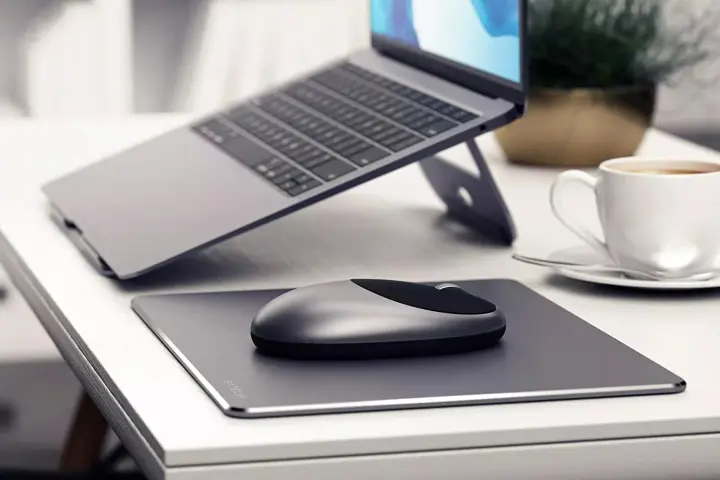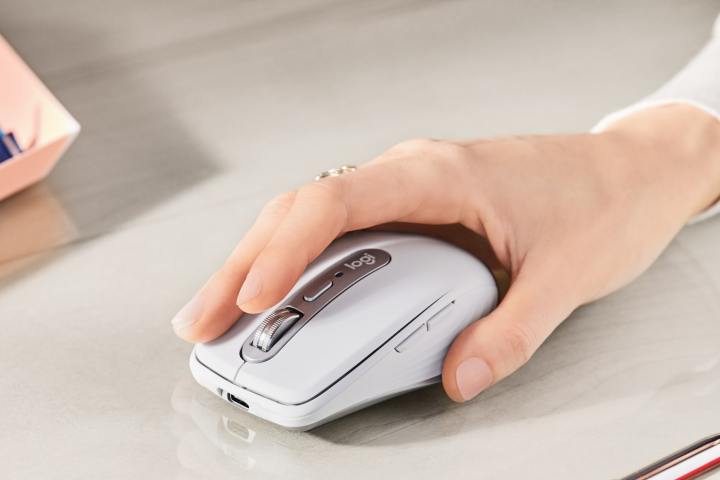6 mice you should buy instead of Apple’s Magic Mouse
Apple’s Magic Mouse has plenty of fans, but it’s definitely not for everyone. For every person who loves its gesture-control surface and sleek design, you’ll find another who’s fed up with its uncomfortable shape and upside-down charging. If that sounds familiar, you might be looking for an alternative mouse for your Mac.
To help, we’ve found six of the best options to replace the Magic Mouse. From productivity masters to gaming aces, these are some of the best mice you can pair with your Apple computer.
Logitech MX Master 3S for Mac

Logitech’s MX Master mice have long been favorites of Mac users, and it’s easy to see why. They offer tons of functionality and comfort without ever sacrificing quality. And when it comes to productivity, they’re second to none.
Worried about losing gesture support if you ditch the Magic Mouse? Fear not, as Logitech has thought of that. The MX Master 3S for Mac has a gesture button at the bottom of its thumb rest — when you press and hold it, you can move the mouse in different directions, and it will perform native macOS gestures. Hold the button and move the mouse forward, for example, and you’ll launch Mission Control. It’s incredibly intuitive and a great replacement for the Magic Mouse’s gestures.
But there’s much more to the MX Master 3S for Mac than just that. It’s got a comfortable, ergonomic shape that will banish wrist pain, its scroll wheel can automatically switch between slow ratcheting and fast spinning (depending on how fast you move it), there’s a thumb wheel for horizontal scrolling, and you can use the mouse on multiple Macs at once, much like Apple’s excellent Universal Control feature. There are so many reasons why Logitech’s mouse is the perfect replacement for the Magic Mouse that we don’t have space for them all here, but if you take the plunge, you’ll see why it’s so well-loved.
Satechi M1 Wireless Mouse

For some people, the Magic Mouse’s low profile is part of the appeal. If you count yourself among their number, but hate how much Apple’s mouse costs, the Satechi M1 Wireless Mouse could be a good alternative. At $30, it has that familiar low-to-the-ground shape (albeit with more ergonomic curves), with none of the sticker shock.
Granted, it doesn’t have a gesture-control surface like the Magic Mouse, but its hard to argue at this price. Yet, don’t mistake it for some cheap, throwaway device — the bulk of its body is made out of aluminum, so it should last you ages. That kind of build quality is uncommon for such an affordable mouse.
Logitech MX Anywhere 3 for Mac

The Logitech MX Anywhere 3 for Mac is the smaller sibling of the MX Master 3S for Mac and packs in some of its best-loved features. At the same time, it comes in a more traditional, less bulky shape that’s better suited to smaller hands.
You’ll find Logitech’s trademark scroll wheel that, the company says, lets you zoom through 1,000 lines in a second. It can scroll slowly with physical ratchets like many of the mice you’re likely used to, but it can also spin incredibly freely and quickly if you move it faster. That adaptability is ideal if you frequently want to use it for different purposes.
With silicone side grips and up to 70 hours of battery life, it should be comfortable and long-lived anywhere you want to use it. And it has a bunch of app-specific shortcuts built in, so you can quickly access tools and settings in apps like Adobe Photoshop, Zoom, Chrome, Microsoft Word and many more.
Anker 2.4G Wireless Vertical Ergonomic Optical Mouse

The main problem with Apple’s Magic Mouse is its shape, which can put a lot of strain on your wrist after a while. To counteract that, a more ergonomic mouse can be an excellent idea — and Anker’s 2.4G Wireless Vertical Ergonomic Optical Mouse is a solid option.
Instead of keeping your hand horizontal, this mouse uses a vertical orientation. This ensures your hand sits in a more natural upright position, which results in less twisting and therefore a more comfortable stance on the mouse. This different shape doesn’t mean you miss out on functionality either, as it has a bunch of extra buttons that can be customized with the right software to enhance your Mac usage.
Anker’s mouse is also far more affordable than the Magic Mouse. Compared to Apple’s $79 pointer, the $25 Anker option is less than a third of the price. That’s a massive saving alongside its prominent health benefits. So, if you’re tired of wrist strain and want a wallet-friendly alternative, it’s a clear choice.
Logitech Pro X Superlight 2

These days, Apple silicon chips like the M3 Max have made the Mac a bona fide gaming machine. The problem, though, is that gaming mice are almost universally garish and ugly, with wide swooping curves and a blinding array of RGB lights everywhere you look. If you want a high-performance gaming mouse for your Mac without all of the unnecessary cruft, your options are limited.
Fortunately, the Logitech Pro X Superlight 2 fits the bill perfectly. As its name suggests, it’s extremely lightweight — just 2.12 ounces — which is perfect for fast-paced games where accuracy is important. It glides so smoothly on your mouse mat that it feels like nothing can drag it down, while its build quality is impressively solid despite its low weight (and it keeps that weight down without cutting cheese grater-like holes in its frame, unlike some rivals).
Another benefit? Its lack of RGB lighting means it has phenomenal battery life, with Logitech promising up to 95 hours of juice on a single charge. So you can game — and work — to your heart’s content. It’s so good that it’s our pick for the best gaming mouse.
Apple Magic Trackpad

If you want an alternative to the Magic Mouse, you don’t necessarily need to look at third-party products — Apple’s Magic Trackpad could be just what you need. You get all of the gesture goodness and Apple’s famous attention to detail rolled into one.
In fact, given the size of the Magic Trackpad, you get much more space for gestures, so if you want something that works with Apple’s swiping shortcuts, the Magic Trackpad offers much more in this regard than even the Magic Mouse. And unlike the Magic Mouse, you can also use it and charge it at the same time.
There are some drawbacks to be aware of. For one thing, it’s no good in gaming, as you can’t be anywhere near as accurate as you would be with a mouse. For another, some users might not find it as comfortable to use as a mouse, especially over long sessions. But there’s still plenty going for it, and it’s worth considering as an alternative to the Magic Mouse.
Apps that support gesture controls
A key selling point of the Magic Mouse is its flat gesture surface, and there aren’t many mice that can properly replicate it. However, that doesn’t mean you have to sacrifice gestures entirely if you buy an alternative mouse.
Apps like BetterTouchTool and Mac Mouse Fix let you assign your own gestures to almost any mouse, meaning you can get back some of the gesture functionality you might lose by ditching the Magic Mouse. They’re definitely worth looking into if gestures are important to your workflow.
Editors’ Recommendations

Apple’s Magic Mouse has plenty of fans, but it’s definitely not for everyone. For every person who loves its gesture-control surface and sleek design, you’ll find another who’s fed up with its uncomfortable shape and upside-down charging. If that sounds familiar, you might be looking for an alternative mouse for your Mac.
To help, we’ve found six of the best options to replace the Magic Mouse. From productivity masters to gaming aces, these are some of the best mice you can pair with your Apple computer.
Logitech MX Master 3S for Mac

Logitech’s MX Master mice have long been favorites of Mac users, and it’s easy to see why. They offer tons of functionality and comfort without ever sacrificing quality. And when it comes to productivity, they’re second to none.
Worried about losing gesture support if you ditch the Magic Mouse? Fear not, as Logitech has thought of that. The MX Master 3S for Mac has a gesture button at the bottom of its thumb rest — when you press and hold it, you can move the mouse in different directions, and it will perform native macOS gestures. Hold the button and move the mouse forward, for example, and you’ll launch Mission Control. It’s incredibly intuitive and a great replacement for the Magic Mouse’s gestures.
But there’s much more to the MX Master 3S for Mac than just that. It’s got a comfortable, ergonomic shape that will banish wrist pain, its scroll wheel can automatically switch between slow ratcheting and fast spinning (depending on how fast you move it), there’s a thumb wheel for horizontal scrolling, and you can use the mouse on multiple Macs at once, much like Apple’s excellent Universal Control feature. There are so many reasons why Logitech’s mouse is the perfect replacement for the Magic Mouse that we don’t have space for them all here, but if you take the plunge, you’ll see why it’s so well-loved.
Satechi M1 Wireless Mouse

For some people, the Magic Mouse’s low profile is part of the appeal. If you count yourself among their number, but hate how much Apple’s mouse costs, the Satechi M1 Wireless Mouse could be a good alternative. At $30, it has that familiar low-to-the-ground shape (albeit with more ergonomic curves), with none of the sticker shock.
Granted, it doesn’t have a gesture-control surface like the Magic Mouse, but its hard to argue at this price. Yet, don’t mistake it for some cheap, throwaway device — the bulk of its body is made out of aluminum, so it should last you ages. That kind of build quality is uncommon for such an affordable mouse.
Logitech MX Anywhere 3 for Mac

The Logitech MX Anywhere 3 for Mac is the smaller sibling of the MX Master 3S for Mac and packs in some of its best-loved features. At the same time, it comes in a more traditional, less bulky shape that’s better suited to smaller hands.
You’ll find Logitech’s trademark scroll wheel that, the company says, lets you zoom through 1,000 lines in a second. It can scroll slowly with physical ratchets like many of the mice you’re likely used to, but it can also spin incredibly freely and quickly if you move it faster. That adaptability is ideal if you frequently want to use it for different purposes.
With silicone side grips and up to 70 hours of battery life, it should be comfortable and long-lived anywhere you want to use it. And it has a bunch of app-specific shortcuts built in, so you can quickly access tools and settings in apps like Adobe Photoshop, Zoom, Chrome, Microsoft Word and many more.
Anker 2.4G Wireless Vertical Ergonomic Optical Mouse

The main problem with Apple’s Magic Mouse is its shape, which can put a lot of strain on your wrist after a while. To counteract that, a more ergonomic mouse can be an excellent idea — and Anker’s 2.4G Wireless Vertical Ergonomic Optical Mouse is a solid option.
Instead of keeping your hand horizontal, this mouse uses a vertical orientation. This ensures your hand sits in a more natural upright position, which results in less twisting and therefore a more comfortable stance on the mouse. This different shape doesn’t mean you miss out on functionality either, as it has a bunch of extra buttons that can be customized with the right software to enhance your Mac usage.
Anker’s mouse is also far more affordable than the Magic Mouse. Compared to Apple’s $79 pointer, the $25 Anker option is less than a third of the price. That’s a massive saving alongside its prominent health benefits. So, if you’re tired of wrist strain and want a wallet-friendly alternative, it’s a clear choice.
Logitech Pro X Superlight 2

These days, Apple silicon chips like the M3 Max have made the Mac a bona fide gaming machine. The problem, though, is that gaming mice are almost universally garish and ugly, with wide swooping curves and a blinding array of RGB lights everywhere you look. If you want a high-performance gaming mouse for your Mac without all of the unnecessary cruft, your options are limited.
Fortunately, the Logitech Pro X Superlight 2 fits the bill perfectly. As its name suggests, it’s extremely lightweight — just 2.12 ounces — which is perfect for fast-paced games where accuracy is important. It glides so smoothly on your mouse mat that it feels like nothing can drag it down, while its build quality is impressively solid despite its low weight (and it keeps that weight down without cutting cheese grater-like holes in its frame, unlike some rivals).
Another benefit? Its lack of RGB lighting means it has phenomenal battery life, with Logitech promising up to 95 hours of juice on a single charge. So you can game — and work — to your heart’s content. It’s so good that it’s our pick for the best gaming mouse.
Apple Magic Trackpad

If you want an alternative to the Magic Mouse, you don’t necessarily need to look at third-party products — Apple’s Magic Trackpad could be just what you need. You get all of the gesture goodness and Apple’s famous attention to detail rolled into one.
In fact, given the size of the Magic Trackpad, you get much more space for gestures, so if you want something that works with Apple’s swiping shortcuts, the Magic Trackpad offers much more in this regard than even the Magic Mouse. And unlike the Magic Mouse, you can also use it and charge it at the same time.
There are some drawbacks to be aware of. For one thing, it’s no good in gaming, as you can’t be anywhere near as accurate as you would be with a mouse. For another, some users might not find it as comfortable to use as a mouse, especially over long sessions. But there’s still plenty going for it, and it’s worth considering as an alternative to the Magic Mouse.
Apps that support gesture controls
A key selling point of the Magic Mouse is its flat gesture surface, and there aren’t many mice that can properly replicate it. However, that doesn’t mean you have to sacrifice gestures entirely if you buy an alternative mouse.
Apps like BetterTouchTool and Mac Mouse Fix let you assign your own gestures to almost any mouse, meaning you can get back some of the gesture functionality you might lose by ditching the Magic Mouse. They’re definitely worth looking into if gestures are important to your workflow.
Editors’ Recommendations
